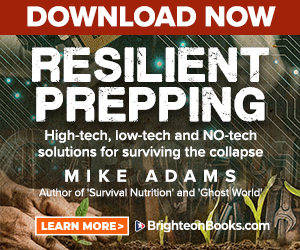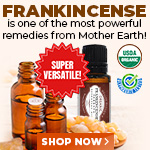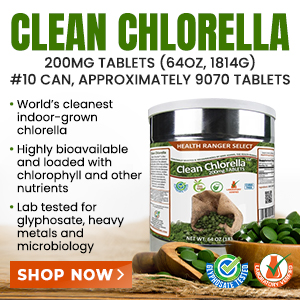
Study supports 'urgent' need for worldwide ban on lead-based paint (press release)
Wednesday, September 20, 2006 by: NewsTarget
Tags: health news, Natural News, nutrition
- Aerosolized bioweapons? Strange “diploid biomasses” falling out of the sky in Florida captured under the microscope
- Widespread social and economic unrest: Steve Quayle issues urgent financial warning of imminent asset collapse in new interview with Mike Adams
- Israeli lobbyists boast of controlling US national security policy in leaked AIPAC audio
- U.S. lawmakers investigate Meta over alleged China collaboration
- Analysis: The coming economic collapse, a mass uprising and Trump's three secret weapons to halt the growing revolt
- Fauci is back in the limelight, and he’s busy promoting a future COVID or FLU pandemic
- Kiss Your Genetic Privacy Good-Bye! 23andMe Gets Green Light to Sell Your Intimate Genetic Details to Anyone They Want
- Warp Speed 2.0: Trump Administration ACCELERATES Gates-funded, self-amplifying bird flu vaccines
- Mike Adams releases country western hit single: Goin’ Back in Time is Comin’ Home
- TAKE IT DOWN Act advances in Congress amid free speech concerns
- DMSO and Natural Dyes: A suppressed cancer treatment resurfaces in independent research
- CLOT SHOT PLANDEMIC UNFOLDING: Fibrous, rubbery clots caused by covid injections have prion-like seeding activity
- Tulsi Gabbard leads charge against the Biden regime’s global censorship of the 'Disinformation Dozen'
- Father speaks out: Challenging the mainstream narrative of his daughter’s “unvaccinated measles death”
- Defunding DEADLY mRNA jabs: Government funding for mRNA technology being scrutinized and sidelined until proven "safe and effective" for real
- Chemical cocktails in processed foods linked to diabetes, validating natural health warnings
- Curcumin’s ancient healing power supercharges muscle recovery, and its effects are compounded with anti-inflammatory foods and supplements
- 6 Seemingly safe US states you should avoid when SHTF
- Aerosolized bioweapons? Strange “diploid biomasses” falling out of the sky in Florida captured under the microscope
- Fauci is back in the limelight, and he’s busy promoting a future COVID or FLU pandemic
- Tulsi Gabbard leads charge against the Biden regime’s global censorship of the 'Disinformation Dozen'
- Analysis: The coming economic collapse, a mass uprising and Trump's three secret weapons to halt the growing revolt
- Widespread social and economic unrest: Steve Quayle issues urgent financial warning of imminent asset collapse in new interview with Mike Adams
- Kiss Your Genetic Privacy Good-Bye! 23andMe Gets Green Light to Sell Your Intimate Genetic Details to Anyone They Want
- U.S. lawmakers investigate Meta over alleged China collaboration
- Mike Adams releases country western hit single: Goin’ Back in Time is Comin’ Home
- Israeli lobbyists boast of controlling US national security policy in leaked AIPAC audio
- Chemtrails unveiled: How the CIA and Big Business are manipulating the weather for profit
- Curcumin’s ancient healing power supercharges muscle recovery, and its effects are compounded with anti-inflammatory foods and supplements
- CLOT SHOT PLANDEMIC UNFOLDING: Fibrous, rubbery clots caused by covid injections have prion-like seeding activity
- China’s counter-tariff strategies: A new chapter in the U.S.-China trade war
- Pfizer's RSV vaccine linked to preterm births as drug giant CONCEALED RISKS from pregnant women in unethical clinical trials
- Shedding light on the dark side of MMR vaccines: How vaccinated individuals SPREAD MEASLES & put the vulnerable at risk
- Dane Wigington exposes climate engineering as ‘All-Out Weather and Biological Warfare’
- Defunding DEADLY mRNA jabs: Government funding for mRNA technology being scrutinized and sidelined until proven "safe and effective" for real
- DEATH by VACCINE or face PRISON time: Canadian Freedom Convoy leaders CONVICTED for protesting forced vaccination during the Covid Plandemic
- Newly released JFK files reveal Pentagon's role in creating Lyme disease and covid in the same lab
- Analysis: The coming economic collapse, a mass uprising and Trump's three secret weapons to halt the growing revolt
- Mike Adams releases country western hit single: Goin’ Back in Time is Comin’ Home
- Aerosolized bioweapons? Strange “diploid biomasses” falling out of the sky in Florida captured under the microscope
- Kiss Your Genetic Privacy Good-Bye! 23andMe Gets Green Light to Sell Your Intimate Genetic Details to Anyone They Want
- European Court of Justice: Healthcare professionals who promoted or administered COVID-19 vaccines are CRIMINALLY LIABLE for any harm caused
- Federal employees whine over DOGE's new directive requiring them to do a 5-point summary of weekly accomplishments
- U.S. approves new Russian ambassador as diplomatic thaw continues
- Government waste exposed: Hegseth supports Musk’s demand for accountability from federal workers
- Now you can HEAR chemistry: Health Ranger translates molecules into music in stunning video demonstration that will blow your mind (and your ears)
- Widespread social and economic unrest: Steve Quayle issues urgent financial warning of imminent asset collapse in new interview with Mike Adams
- Dr. Mike Yeadon releases 15-minute testimony - WATCH - about genocidal intent of COVID “vaccines”
- The Health Ranger releases “Vaccine Zombie” song and music video, using AI-animated zombies for the music video
- Trump reverses course on Gaza plan, says “nobody is expelling Palestinians”
- EPA advisor admits the agency is funneling billions to climate groups ahead of Trump’s return to White House
- 5 Simple steps to boost your brainpower: How to strengthen executive function in a distracted world
- I Want My Bailout Money – new song and music video released by Mike Adams
- Tulsi Gabbard leads charge against the Biden regime’s global censorship of the 'Disinformation Dozen'
- Red Cross issues warning to stop blood plasma donations from vaccinated people
- Scientists confirm: GENIUS brain function can be spontaneously unleashed in humans without any apparent cause
- EPA advisor admits the agency is funneling billions to climate groups ahead of Trump’s return to White House
- HYSSOP: What research reveals about the health benefits of this ancient holy herb
- Two containers with completed ballots fall out of truck in Florida
- Newly released JFK files reveal Pentagon's role in creating Lyme disease and covid in the same lab
- Global leaders unite to clamp down on “misinformation” with UN-backed Cascais Declaration
- BREAKING: 2025 NDAA authorizes mandatory military draft of WOMEN across America… as Pentagon pursues global NUCLEAR war with both Russia and China at the same time
- Mike Adams releases country western hit single: Goin’ Back in Time is Comin’ Home
- Michael Yon warns of a ZIONIST TAKEOVER in Trump’s second administration
- Ozempic and Wegovy weight loss drugs are injectable LIZARD VENOM PEPTIDES that may unleash a devastating wave of organ failure… side effects align with symptoms of SNAKE BITES
- The Health Ranger releases “Vaccine Zombie” song and music video, using AI-animated zombies for the music video
- BOMBSHELL: DNA testing kits are a SCAM to develop ethnic-specific bioweapons
- Israeli soldiers accused of even more torture and abuse in the West Bank
- These 13 countries just signed an agreement to engineer a global FAMINE by destroying food supply
- I Want My Bailout Money – new song released by Mike Adams
- NASA admits that climate change occurs because of changes in Earth’s solar orbit, and NOT because of SUVs and fossil fuels
- RFK Jr. clears key hurdle: Sen. Susan Collins backs controversial HHS nominee, signaling a new era for health policy
The report appears in the early online edition of the journal Environmental Research, to be published in September 2006.
The researchers say that this lead-based paint production poses a global health threat, and a worldwide ban is urgently needed to avoid future public health problems.
Lead is a malleable metal previously used to improve the durability and color luster of paint used in homes and other buildings and on steel structures, such as bridges. Now scientifically linked to impaired intellectual and physical growth in children, lead is also found in some commonly imported consumer products, including candy, folk and traditional medications, ceramic dinnerware and metallic toys and trinkets.
In a two-year study headed by Scott Clark, PhD, the UC-led research team found that more than 75 percent of the consumer paint tested from countries without controls--including India, Malaysia and China--had levels exceeding U.S. regulations. Collectively, the countries represent more than 2.5 billion people. In Singapore, which enforces the same lead restriction on new paint as the United States, lead levels were significantly lower.
"Paint manufacturers are aggressively marketing lead-based paints in countries without lead content restrictions," says Clark, professor of environmental health at UC. "In some cases, companies are offering the same or similar products, minus the lead, in a regulated country."
"There is a clear discrepancy in product safety outside the United States," he adds, "and in today's global economy, it would be irresponsible for us to ignore the public health threat for the citizens in the offending countries--as well as the countries they do business with."
This study, Dr. Clark says, is believed to be the first to show that new paint in many unregulated Asian countries greatly exceeds U.S. safety levels.
The UC-led team analyzed 80 consumer paint samples of various colors and brands from four countries--India, Malaysia, China and Singapore--to determine the amount of lead and compare them with U.S. standards.
Each paint sample was applied in a single layer to a wood block, left to dry and then removed and analyzed in UC laboratories for lead content.
About 50 percent of the paint sold in China, India and Malaysia--none of which appear to have regulations on lead--had lead levels 30 times higher than U.S. regulations. In contrast in Singapore, which has well-enforced regulations, only 10 percent of paint samples were above U.S. regulations, the highest being six times the U.S. limit.
Clark says he is concerned about children who are currently exposed to lead in their houses and neighborhoods--and for those who will live in such places in the future.
"Lead-based paints have already poisoned millions of children in the United States and will likely cause similar damage in the future as paint use increases in Asian countries and elsewhere," he says. "Our findings provide stark evidence of the urgent need for an effective worldwide ban on the use of lead-based paint."
Children are particularly susceptible to lead poisoning for a number of reasons, including their natural hand-to-mouth behaviors. Workers responsible for removing lead-based paint are also at high risk for lead poisoning.
In 1978, the United States restricted lead content in paint after determining that people--especially young children--were being poisoned by environmental exposures to the element. Many Third World countries, says Clark, did not follow suit, and continue to manufacture and sell lead-based paints that would be prohibited in the United States and in some other countries.
"We've known for years that there are good substitutes for lead in paint," he continues, "so it's absolutely incomprehensible that paint manufacturers--particularly large companies with plentiful resources--would knowingly distribute a product that can be dangerous to people."
"Some lead-contaminated items intended for use by children, painted playground equipment, for example, are manufactured in countries with limited to zero government regulation on lead in consumer products," says Clark.
Although American brand paints were not available for purchase in this study, several U.S. multinational paint companies are among the top in Asia and some Asian paint companies have arrangements with U.S. companies.
"American companies need to take a stand and encourage their international collaborators to demand lower lead contents in consumer products--including paint," he adds. "It's not only the ethical thing to do, it's the fiscally responsible choice to prevent billions of dollars in future health costs and property clean-up costs."
Contact: Amanda Harper amanda.harper@uc.edu 513-558-4657 University of Cincinnati
Health news at FETCH.news
Get independent news alerts on natural cures, food lab tests, cannabis medicine, science, robotics, drones, privacy and more.
Take Action: Support Natural News by linking to this article from your website
Permalink to this article:
Embed article link: (copy HTML code below):
Reprinting this article:
Non-commercial use OK, cite NaturalNews.com with clickable link.
Follow Natural News on Facebook, Twitter, Google Plus, and Pinterest
Science News & Studies
Medicine News and Information
Food News & Studies
Health News & Studies
Herbs News & Information
Pollution News & Studies
Cancer News & Studies
Climate News & Studies
Survival News & Information
Gear News & Information
News covering technology, stocks, hackers, and more



"Big Tech and mainstream media are constantly trying to silence the independent voices that dare to bring you the truth about toxic food ingredients, dangerous medications and the failed, fraudulent science of the profit-driven medical establishment.
Email is one of the best ways to make sure you stay informed, without the censorship of the tech giants (Google, Apple, Facebook, Twitter, YouTube, etc.). Stay informed and you'll even likely learn information that may help save your own life."
–The Health Ranger, Mike Adams













































